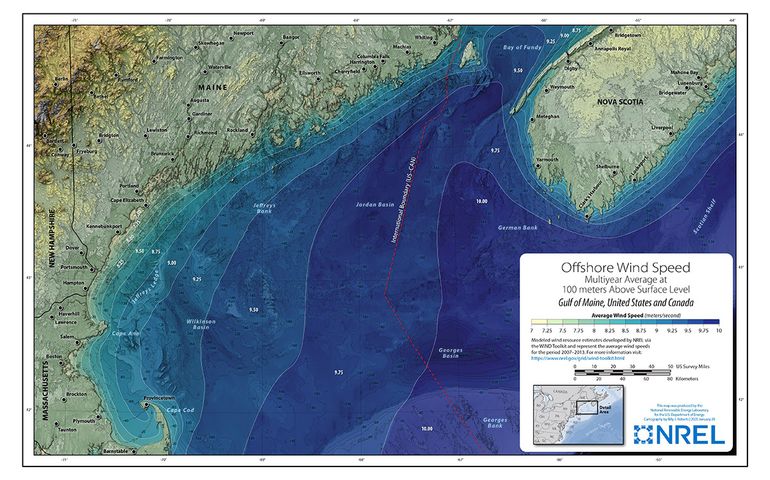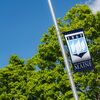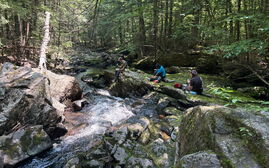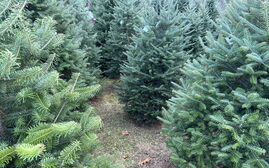Fishery group pans loss of fishing ground in Mills offshore wind plan
 Courtesy / Governor’s Energy Office
The shading on this map shows gradations of wind velocity in the Gulf of Maine, where winds are stronger than onshore. Gov. Janet Mills last week announced a plan to create a 16-square-mile offshore wind research array in the gulf.
Courtesy / Governor’s Energy Office
The shading on this map shows gradations of wind velocity in the Gulf of Maine, where winds are stronger than onshore. Gov. Janet Mills last week announced a plan to create a 16-square-mile offshore wind research array in the gulf.
The Maine Coast Fishermen’s Association in Brunswick last week objected to Gov. Janet Mills’ plan to create a 16-square-mile offshore wind research array in the Gulf of Maine.
“Developing renewable energy solutions is an important component to addressing our shared climate crisis, but it shouldn't be at the expense of the iconic fishermen, seafood providers and fishing communities who keep us fed and support the local economy,” Ben Martens, the association’s executive director, said in a news release.
“The loss of 16 miles of fishing grounds has the potential to have a profoundly negative impact on some of our most cherished fishing communities and as such the state of Maine must establish a best-in-class outreach program focused on transparency that includes fishermen throughout the decision-making process.”
Martens issued the statement shortly after Mills announced her intention to expand research and development of wind-power turbines floating in waters off the Maine coast.
The project would be the nation’s first floating offshore wind research array, according to a separate news release.
In her statement, Mills said the new technology would advance in collaboration with Maine’s fishing industry.
“A research area is a prudent step toward securing our state’s leadership position, working collaboratively with fishermen and scientists, and developing offshore wind to realize the significant energy, economic and climate benefits it stands to offer our state,” Mills said.
But Alex Todd, chairman of Maine Coast Fishermen’s Association board, said his group has “some real concerns with the speed at which this process seems to be moving.
“With the global pandemic limiting the ability to hold real and meaningful conversations, we hope that the governor’s office will take the time necessary to truly engage and listen to the fishing industry,” Todd continued. “For the sake of the next generation of fishermen from Maine, we can’t rush this process.”
Most wind leases last for 30 years, potentially closing fishing grounds to fishermen for an entire generation.
World-class wind speed
With some of the highest sustained wind speeds in the world, the outer continental shelf in the Gulf of Maine has great potential for generating clean energy and economic opportunity for Maine, as offshore wind investment in the U.S. is estimated to top $70 billion through 2030.
With its deep waters, the Gulf of Maine could generate a substantial amount of wind energy from floating offshore wind turbines. But the technology is still under development in the U.S., which requires additional scientific study about its potential effect on fisheries and the marine environment.
The research array is part of the ongoing Maine Offshore Wind Initiative announced by Mills in 2019. In October, the state received a grant from the U.S. Economic Development Agency to support long-term planning for offshore wind with fishery, business, environmental and science representatives, as well as assessing port and infrastructure needs and evaluating the supply chain, manufacturing, and workforce opportunities.
The state intends to file an application for the research array with the Bureau of Ocean Energy Management, which oversees renewable energy development in federal waters, which begin more than 3 miles off the coast.
The array would be located 20 to 40 miles offshore into the Gulf of Maine, in an area that would allow a connection to the mainland electric grid in the southern half of the state. The array is expected to contain a dozen or fewer floating wind turbines. By comparison, commercial offshore wind lease areas elsewhere along the East Coast are frequently greater than 10 times that size.
Mills has directed the Governor’s Energy Office to work with Maine’s commercial fishing industry, the Department of Marine Resources and other interested parties to determine the site for the array.
“Maine’s fishing industry is a vital part of our state’s economy, heritage and identity. Its voice must be heard when considering this new offshore wind technology,” said Patrick Keliher, commissioner of the Department of Marine Resources.
“The department welcomes the chance to work proactively with the fishing industry to hear and understand its concerns about offshore wind, and to ensure its perspectives inform the development and operation of the research array in the Gulf of Maine.”
The state’s partners in the research include the University of Maine, whose floating foundations will be utilized in the array, and New England Aqua Ventus, a joint venture of Diamond Offshore Wind, a subsidiary of Mitsubishi Corporation, and RWE Renewables, one of the world’s largest offshore wind energy companies — which will lead the array’s development.
Climate goals
Harnessing the wind resources off the coast of Maine is considered critical to meet the state’s climate goals of moving Maine to using 80% renewable energy by 2030, and 100% by 2050.
Grant Provost, business agent for Ironworkers Local 7, said offshore wind “is an excellent avenue to transition Maine to a cleaner energy future ... The ironworkers view offshore wind as a great way to create good-paying working class jobs to keep Mainers in the state and we have the skilled union workforce to do the job right and we’re ready to get to work.”
Dana Connors, president of the Maine State Chamber of Commerce, called offshore wind an opportunity for Maine’s energy and marine businesses to strengthen the state’s economy.
“Maine’s companies are well positioned to seize this opportunity and build expertise for the 21st century, and I applaud the Mills Administration for making this a priority,” Connors said.
Through the Maine Offshore Wind Initiative, Mills in March identified Mack Port Terminal in Searsport as a potential site for opportunities to support Maine’s renewable energy industry, specifically offshore wind, and called for a study to analyze them.
That study is expected later this year.
Maine is also continuing to work with New Hampshire and Massachusetts on BOEM’s Gulf of Maine Task Force to evaluate commercial scale renewable energy leasing and development on the outer continental shelf.
In October, the federal government awarded a $2.17 million grant to Maine to develop a roadmap for establishing an offshore wind power industry.
Mainebiz web partners
The Gulf of Maine has an area of 36,000 square miles yet commercial fishing interests squawk when 16 square miles (0.04%) are to be set aside to explore the potential of offshore wind - and even when they have been invited to help identify its location. A cursory look at the potential for economic benefit to working waterfronts would reveal a true win-win situation. But the parochial hoarding of bottom is genetic to commercial fisheries and they may never learn the value of cooperation.
Even if fishing is disallowed in the area, it would serve as a marine protected area of great benefit to commercial fishing stocks in surround areas.














1 Comments